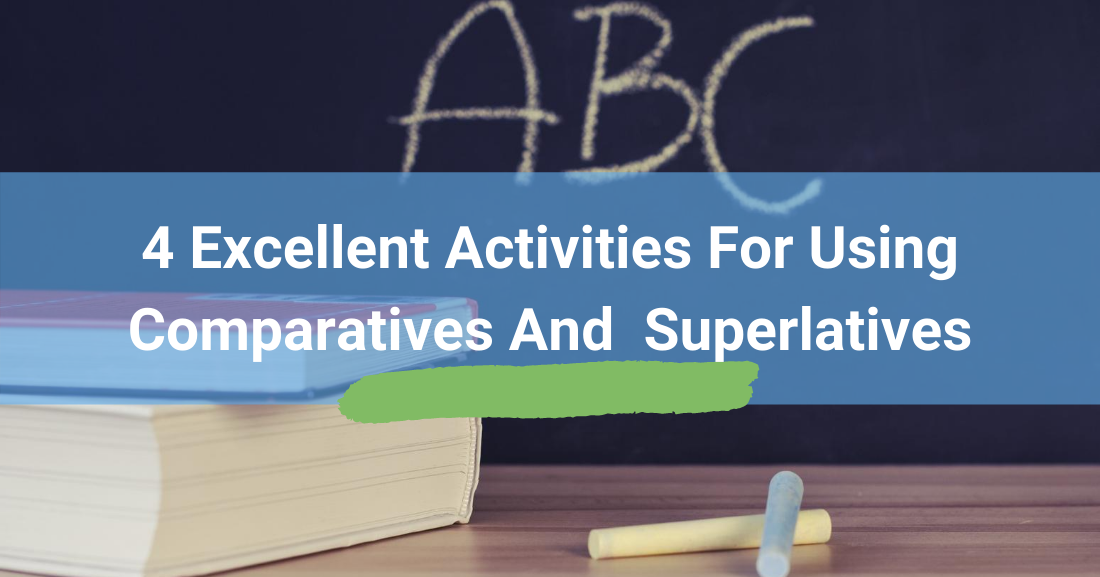7 Excellent Activities for Using Comparatives and Superlatives: The Best and the Brightest


That’s why teaching about intensity is good for your ESL students. When your students can express intensity, they can communicate how they feel about the world around them – both with their classmates and with people outside the classroom – and how strong those feelings are. Here are three different strategies your students can use to share with others exactly how they feel.

When it’s time to talk grammar with your ESL class, a review of comparative and superlative adjectives is a good way to help them express how they feel. Every adjective in English can be expressed in three forms – the positive, the comparative, and the superlative. The positive is the unaltered form of the adjective. E.g. Motorcycles are exciting. The comparative form of the adjective does just what it sounds like – it compares two different items with one comparative adjective. In English, most one syllable words use the suffix –er to express the comparative form: bigger, louder, wilder, etc. Most adjectives of two or more syllables are preceded by the word “more” in their comparative form: more dangerous, more relaxing, more peaceful, etc. For example, motorcycles are more dangerous than cars. Superlative forms of adjectives are used to describe items that are the ultimate representation of that adjective. No other item has that quality more than the one described by the superlative. E.g. Motorcycles are the most thrilling means of transportation. No other transportation is more thrilling. For most single syllable adjectives in English, superlative adjectives are formed by adding the suffix –est: bluest, loudest, dumbest. For most adjectives of two or more syllables in English, “most” precedes the adjective in its superlative form: most exciting, most frightening, most relaxing. Of course, there are exceptions to the comparative and superlative spelling rules: good/better/best, bad/worse/worst, little/less/least, and many/more/most.
To give your students practice with comparative and superlative adjectives, put together a list of simple nouns that they are familiar with. Either write these nouns on index cards yourself or have pairs of students do it. Students then take turns drawing a card with a noun written on it. The student who drew the card makes a statement using a positive adjective and the noun he or she drew. For example, a student who draws “dog” might say this: the cute dog is over there. His partner must then make a statement using that adjective in its comparative form with the same noun. For example, a dog is cuter than a cat. The first student then uses that adjective in its superlative form: bunnies are the cutest pets of all. Now the second student draws a card and students make statements about it. Continue until all the cards have been used.
If you are teaching your students how to express intensity, you might want to try teaching word families. Word families are words that are related in meaning but express different intensities of the same sentiment. For example, like, love, and adore would be a word family that express affection for someone or something. A similar but opposite word family would be dislike, hate, detest. Each verb is more intense than the one before it. A thesaurus is a great resource for coming up with word families, and you can even teach your students to use the reference book and come up with their own word families.
To help students remember that these words have different intensities, I like to use paint color sample cards in class. I give each student one card (which has at least three degrees of the same color on it) for each word family I am teaching them. I then have students write the mildest word on the lightest color, the more intense word on the middle color, and the most intense word on the darkest color. This helps students remember that the words are related in meaning but not exactly the same just as the colors are. Then I have students practice using the different degrees of intensity by writing groups of sentences for each word family. You could also have students share their sentences with a partner orally. Other word families you might want to include are walk/run/race, spook/scare/terrify, sadden/depress/devastate, tasty/delicious/exquisite, look/watch/stare, etc.
One aspect of expressing intensity is expressing the lack of intensity, or a neutral feeling on a particular topic. The following expressions are all used by English speakers to express neutral feelings on a topic.
Introduce your students to these phrases, and then have them work with a partner to practice using them. The first speaker should offer a choice to his partner, something that is rather insignificant. For example, do you want a blue pen or a black pen? Do you prefer Tuesday or Wednesday? Do you like the temperature set at 66 or 68? His partner should then use one of the expressions of neutrality to answer. (E.g. Either is fine with me.) Students take turns offering choices and expressing neutrality until you call time.
You can use this activity as a review of all the different ways speakers can express intensity. Give students a list of questions about their favorite things: restaurant, type of music, type of shoes, etc. Have each person write a sentence on their paper stating which their favorite for each category is. Then, after everyone has finished, have your students mingle, asking their classmates about their favorite things. Students will be looking for someone with the same answer as they put down. So if they said heavy metal is their favorite type of music, they will have to ask their classmates until they find someone else who said heavy metal is their favorite type of music. When they find a match, they write that person’s name on their paper. As students answer questions about their favorites, they should use the different way of expressing intensity to answer. Give your students as much time as they like, then see who was able to find the most matches to their own favorites.
It’s important to be honest about how you feel, and giving your students the tools to express intensity of their own feelings is important. It helps them communicate with the people around them and gives a voice to their preferences.
Do you teach specific strategies?